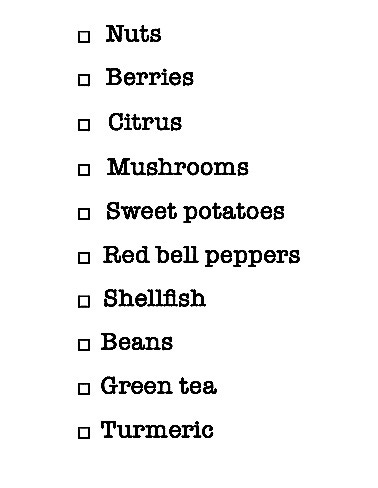Defense Mechanisms: Virus-fighting foods and a checklist for immune health
Spurred by the pandemic, nutrition science has uncovered nutrients that fight COVID to flu - our best weapons against the next viral outbreak
We all know we need to eat healthier, but it’s a hard thing to know how to focus one’s efforts. So, as an MD, I offer strategies to help you eat with impact for yourself, your kids, and the people you feed.
When it comes to investments, the DOD recognizes that bettering the health of the forces is as critical as dollars spent stocking Tomahawks and long-range precision missiles in its silos. Earlier in April, a memorandum announced Defense will be axing $5.1 billion in private sector and IT contracts. "Instead of $500 an hour business process consultants," said Secretary Pete Hegseth, “We need this money to spend on better health care for our warfighters and their families.” Politics aside, this may be one military maneuver worthy of the US Army flag’s “This We’ll Defend.”
Avian flu, measles, COVID-19, norovirus, H3N2
If the pandemic taught us anything, two truths can be had:
The high percentage of adults in the US (estimated at 80%), Canada, and Britain living with metabolic diseases increased COVID-19 severity and hospitalizations and ratcheted up mortality. A metabolically healthier population could have lessened the damage.
While we are still struggling to find effective anti-viral medications, an adequate supply of certain vitamins, minerals, and bioactive nutrients have the potential to reduce risks from COVID and similar SARS diseases like MERS and the common cold.
That makes diet perhaps the most underutilized weapon against communicable disease in the armamentarium of US public health messaging.
Dariush Mozaffarian, a cardiologist and the Dean of the Tufts Friedman School of Nutrition Science and Policy, pointed out early in the pandemic that diet could be a powerful tool to “flatten the curve.” In just 5-6 weeks, he implored a five-ingredient recipe TikTok-philic, fast-food, UPF-prone nation, a dietary reset could make meaningful change in any individual’s metabolic health better insulating them against illness. That includes cardiovascular disease, hypertension, high blood lipids, obesity, pre-diabetes, or adult-onset diabetes. There were a host of foods under study for their immune-boosting potential and a provision list he’d compiled of foods high in immune-essential vitamins and minerals with virus-fighting potential:
In the post-pandemic era, though more are cooking at home, the quality of grocery preprepared and restaurant foods, the second kitchen for many, hasn’t improved all that much. Profit margins are even more stressed by lingering supply chain issues, bird flu, egg shortages, looming tariffs and immigration crack-downs. With costs and threats high, food quality suffers. The need for improvements is even more compounded by adult-onset diabetes rising in tweens and teens linked to previous COVID infection and they will assuredly face a future of cardiovascular disease that diabetes promotes.
One positive outcome…the pandemic helped to foster more research on immune health promoting nutrition, focusing on foods that support protection from viruses, T- and B-cell cell function, and counter the excessive immune response that can be incited by severe acute and long COVID. Viruses like SARS-CoV-2, HIV, and influenza lead to oxidative stress and an impaired stress responses that help the virus life cycle. In the aftermath of infection, oxidative stress and lingering inflammation have emerged as potential contributors to the neurological symptoms like brain fog and decreased energy, fatigue, anxiety, and depression that some COVID-19 sufferers report can linger for 3-4 months.
Five years later, the research spurred has made the case that healthier diets may be our best weapon against the next outbreak. Some nutrients have been found to carry out direct warfare on COVID. Green tea extracts containing epigallocatechin gallate (EGCG), a green tea polyphenol, inhibit the protease SARS-CoV-2 and coronavirus replication. The results of another study found curcumin directly inhibits SARS-CoV-2 virus binding to the host ACE-2 receptor.
Other nutrients help support the body’s natural defenses and dampen immune dysregulation caused by the body’s inflammatory response. To right these imbalance, diets like the Mediterranean Diet, the DASH diet, and plant-forward eating that focus on breadth (fruits, vegetables, beans, whole grains, seafood, lean meats, nuts, and seeds) make the case for the synergy of foods over protein powders and singular supplements .
So, I thought we should take stock of the evidence coming out of the pandemic…Which are the vitamins, minerals, and nutrients essential to healthy regulation of the immune system? What are the foods in which we can find them?
Minerals
Selenium
In China, the recovery rate of people with COVID-19 in the city of Enshi was almost three times higher than in Wuhan and other Hubei province cities. The people of Enshi have one of the highest selenium intakes in the world. Viruses and the inflammatory state they create produce reactive oxygen species, the “free radicals” that “antioxidants” are known to fight. Adequate levels of selenium-bound proteins and enzymes are required for the body to balance pro- and anti- inflammatory equilibrium as well as to slow viral replication and mutation.
Best sources of selenium: Brazil nuts, seafood (tuna, sardines, shrimp), poultry, lean meats, whole grains (oatmeal, brown rice), beans, lentils, mushrooms, and dairy products (yogurt, cottage cheese).
Zinc
Zinc is essential to catalyze the function of hundreds of enzymes, including regulation of gene expression and protein integrity. There’s a reason you’ve heard of zinc for the common cold. It has been found that zinc (lozenges or syrup) reduces the average duration of the common cold caused by rhinovirus in healthy people when taken within 24 hours of onset of symptoms.
Best sources of zinc: Seafood (oysters, crab, shrimp, sardines), poultry, lean meats (beef, pork), nuts, seeds (pumpkin seeds), oats, lentils, fortified breakfast cereals, mushrooms, dairy.
Iron
Iron is in many cellular processes including oxygen transport/ sensing, energy metabolism, and DNA synthesis and plays a role in both promoting and mitigating inflammation and responding to stress.
Best sources of iron: Shellfish (oysters, mussels, clams, sardines, shrimp), poultry, lean meats, sesame seeds, nuts, fortified breakfast cereals, oats, spinach, soybeans, Swiss chard, tomatoes, broccoli, beans, lentils, leeks, sweet potatoes.
Phytonutrients
Plant species must bear up under the stress of drought and heat, so they have evolved a wealth of phyto(plant)-nutrients which act as potent antioxidants. These compounds also deter pests and decay through their natural bactericidal, ant-viral, and anti-fungal functions. When we eat them, we benefit.
Hesperidin
Citrus offers plant polyphenol compounds, particularly hesperidin, that have activity against coronaviruses. Hesperidin can bind directly to the COVID-19 spike protein interfering with cell latching and entry. It boosts the response to viral infections by both enhancing immune pathways and down-regulating excessive inflammation that can cause organ damage.
Best Sources of Hesperidin: The Hesperides were handmaiden nymphs given the task of tending Hera and Zeus’ garden planted from “branches laden with golden apples”, likely oranges. Hesperidin can be found in all citrus: oranges, sour oranges, clementines, lemons, limes and grapefruits, particularly in their peels and fruit membranes.
Flavanols and Catechins
Green tea is rich in many classes of flavonoids and flavanol-like catechins. Although they are present in other forms of tea, a cup of brewed green tea can deliver about 200–300 mg of the potent catechin EGCG [(-)-epigallocatechin-3-gallate.] EGCG in green tea extracts has been shown to inhibit replication of DNA viruses such as herpes simplex at doses from 800 mg. Kaempferol, another flavanol, has anti-bacterial, anti-fungal and anti-viral activity against a wealth of viruses, including the original 2002-2004 SARS-COV-1 strain. Kaempferol and the flavanol quercetin have both been shown to inhibit COVID-19 viral cell entry and potentially impede infection. More research is required to determine if flavanols in amounts derived from diet can directly reduce risks of viral illness, but they do support healthy regulation of the body’s viral and inflammatory response pathways.
Best sources of Flavonoids, flavanols,, and catechins: green tea, decaf green tea, black tea, cacao, oolong, raw apples, almonds, hazelnuts, black plums, black grapes, dark chocolate, blueberries, blackberries, caperberries; Kaempferol: Berries, tea, almond, beans, broccoli, cabbage, grapes, kale, strawberries, tomatoes, citrus, Brussel sprouts, grapefruit, beans, cumin; Quercetin: cocoa, mint, apples, berries, grapes, red onions, broccoli, black red pepper, red wine, tomatoes.
Proanthocyanidins
Berries offer compounds, proanthocyanidins, which give fruits and vegetables their blue, and purple hues. These compounds have been studied to inhibit viral cell entry for influenza and norovirus and they scavenge free radicals from the body before damage can be done.
Best sources of proanthocyanidins: barley, hops, corn, apples, grapes, beans, strawberries, blueberries, kiwis, cranberries, cherries, apricots, mangoes, almonds, hazelnuts, walnuts, pistachios, and peanuts, cocoa, almonds, cinnamon, peanuts, and tea.
Vitamins
Red bell peppers offer nearly twice as much Vitamin C as citrus fruits and are high in pro-vitamin A (beta carotene) which is converted into Vitamin A. Sweet potatoes offer 150% of the recommended daily value for Vitamin A, including retinol and beta-carotene, which are essential to regulate the evolving immune response when defending against the body’s intruders.
Best Sources of Vitamin A: Sweet potatoes, dark leafy greens: spinach, collards, kale, Romaine, broccoli ; orange and yellow vegetables: pumpkin, squash, carrots, cantaloupe, mangos, tomatoes; Seafood: herring, salmon; vegetable oils, dairy, fortified breakfast cereals.
Vitamin C plays many critical roles important to protein metabolism, utilization of iron, and management of oxidative stress. In the body, it can be found in highest concentration in white blood cells and facilitates their migration to sites of infection, pathogen destruction, and antibody production.
Best Sources of Vitamin C: Red bell pepper, citrus: oranges, clementines, grapefruit, lemons, limes; strawberries, kiwi, Brussel sprouts, cauliflower, tomatoes, cantaloupe, potatoes, green peppers.
Vitamin B, pyridoxine (B6), folate (B9), cobalamin (B12)
B vitamins are a complex of eight water-soluble compounds that perform a vast array of functions related to protein utilization, cognitive health, and immune function. The body does not store them, so they need to be replenished daily. They promote white cell development and T- and B-cell signaling through virus-fighting factors like interleukin-2.
Best Sources of Vitamin B6: pyridoxine: chickpeas, beans, seafood (salmon, tuna), poultry, lean meats, potatoes, bananas, tomatoes, whole grains, dairy, nuts; folate: dark leafy green (spinach, kale, collards, Swiss chard, Romaine) asparagus, Brussel sprouts, avocado, fortified breads and cereals, tomatoes, nuts, whole grains, eggs, dairy; cobalamin: shellfish (clams, oysters), seafood meat, poultry, eggs, and dairy products.
Vitamin D refers to a family of hormones that act as transcription factors in order for synthesis of proteins to occur from genes. Ergocalciferol (Vitamin D2) is produced in plants and in human skin through UVB radiation or sunlight exposure. Another precursor cholecalciferol (Vitamin D3) is found in oily fish. Mushrooms exposed to sunlight and salmon are the two greatest sources of vitamin D2 and D3 in American diets.
Best Sources of Vitamin D: Fish and shellfish, eggs, meat, milk, beans and lentils, wild mushrooms, and whole grains. Adequate Vitamin D from foods is difficult to source in food alone in an age of industrialized farming.
Curcuminoids
Turmeric, the spice that puts the yellow in curry powder, gets its hue from curcumin. Six studies during the pandemic demonstrated that curcumin supplementation led to a significant decrease in common COVID-19 symptoms, reduced hospitalization duration, and decreased mortality rates. Circuminoids are theorized to have anti-viral properties and also work to restore the balance between inflammatory and anti-inflammatory body responses through immune regulation. Further studies are needed to identify dosing for safety and anti-viral efficacy.

It goes without saying that the best protection against viral illnesses is to keep the whole hive in good health with vaccines. Until recently, smallpox, poliomyelitis, measles, and rubella were eliminated from America due to high compliance with vaccine recommendations. When most of the population is protected against viral illness, there is less circulating virus hence less opportunity for virus to wreak havoc by mutating into more aggressive strains. High vaccination rates also protect those folks who cannot receive vaccines like infants, cancer patients, and the immunocompromised through “herd immunity.” When most of the bees in the nest remain virus-free, the most vulnerable are safer.
But, a varied diet can be seen as the “Force behind the Forces.” Because of perishability and poor re-heatability, you won’t readily find many of the foods listed above in pre-prepared meals through they are worth your self-investment. The labor, costs, and time you put into shopping foods like fresh berries, bell peppers, citrus, dark leafy greens, and shellfish may keep you from a week of the grip spent in bed next flu season. More importantly, had fresh fruits and vegetables been more accessible in food deserts, more easily purchased by elderly folks,… In rural areas where food shopping is done in mega-superstores and fast food restaurants are the only dining out choices, had high nutrient foods replaced the high salt, high calorie, high sugar options readily available…perhaps the severity of COVID and the lives lost might have been less tragic.
We can only look forward and march on.
While eating with intention, you can learn here how to celebrate seasonal produce and quality ingredients in recipes that promote not just longevity but vibrant life—-for yourself, for your family, for your children, and all the people you feed!
You’ll find lots of additional recipes for inspiration at www.ellenkornmehlmd.com and in the Eating and Feeding Archive. Follow @mdwritesrecipes on Instagram to see what I’m cooking.
Piedmontese Tuna-Stuffed Mini-Peppers
Mussels with Sweet Tomato Jam on Sourdough
Greek Yogurt with Strawberries Poached in Red Wine
I’d like to help you and your family intuit better choices when you shop, dine out, and cook at home.
I value your likes and comments…they let me know what info you find betters your everyday life! Please drop a comment!









So well done and I am a devoted reader.
So fascinating to have this look at all the more recent scientific research into the undoubted relationship between diet and health. I fear for the future with the anti-science team in charge in Washington and the drastic cuts to both personnel and funding of the places where this very research has been carried out.